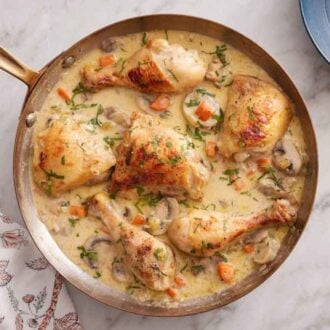
Chicken Fricassée
If you've ever craved a meal that seamlessly blends the warmth of comfort food with the sophisticated allure of French cuisine, my Chicken Fricassée recipe is for you.
Servings 4 servings
Calories 715kcal
Equipment
- Large skillet
Ingredients
- 3 bone-in, skin-on chicken thighs
- 3 chicken drumsticks
- 1½ teaspoons salt divided
- 1 teaspoon ground black pepper divided
- 2 tablespoons olive oil
- 2 tablespoons unsalted butter
- 1 cup chopped yellow onion (52g)
- ½ cup chopped carrot (26g)
- ½ cup chopped celery (26g)
- 8 ounces white mushrooms sliced (227g)
- 3 garlic cloves minced
- ½ cup white wine (120mL)
- 1½ cups chicken broth (360mL)
- 1 cup heavy cream (240mL)
- 1 tablespoon fresh thyme leaves
- 1 tablespoon chopped fresh flat-leaf parsley
Instructions
- Sprinkle both sides of the chicken pieces with 1 teaspoon salt and ½ teaspoon pepper.
- In a large skillet, warm the olive oil over medium-high heat. Add the chicken pieces, cooking until the skin is browned, about 3 to 4 minutes on each side. Remove the chicken from the skillet and let rest on a plate.
- Reduce the heat to medium. Add the butter to the skillet and swirl until melted. Add the onion, carrot, celery, mushrooms, and garlic. Cook, stirring frequently until softened, about 7 minutes. Stir in the wine and cook until the wine reduces by half, about 4 to 5 minutes.
- Stir in the broth, cream, thyme, ½ teaspoon salt, and ½ teaspoon pepper. Bring to a simmer.
- Return the chicken and the resting juices to the skillet, and reduce the heat to medium-low. Simmer until the chicken is cooked through, registering 165F on a meat thermometer when inserted into the thickest portion of the chicken pieces, and the sauce is slightly thickened, about 25 minutes. Serve immediately garnished with parsley.
Notes
- For a thicker sauce, remove the chicken after 25 minutes of cooking and continue to simmer the sauce until you reach your desired consistency. Alternatively, dissolve 1 teaspoon of cornstarch in 1 tablespoon of water and stir the slurry into the sauce, cooking and stirring until thickened. Then, return the chicken to the creamy sauce.
- Consider air-drying your chicken. Moisture is the enemy of browning. In order to achieve the signature golden skin on traditional chicken fricassee, I find that patting the chicken pieces dry with a clean paper towel, seasoning them, and then placing them on a plate back in the fridge (uncovered) for 4-24 hours to dry is the best method. It adds a little bit of prep work, but it’s worth it in the end.
- Invest in an instant-read meat thermometer. For food safety, chicken should hit an internal temperature of 165°F, but you also don’t want to overcook it or risk drying out the meat. Using a thermometer is the easiest way to get deliciously replicable results every single time without guessing about the cooking time.
Nutrition
Calories: 715kcal | Carbohydrates: 12g | Protein: 33g | Fat: 58g | Saturated Fat: 25g | Polyunsaturated Fat: 7g | Monounsaturated Fat: 22g | Trans Fat: 0.3g | Cholesterol: 242mg | Sodium: 1387mg | Potassium: 799mg | Fiber: 2g | Sugar: 6g | Vitamin A: 4063IU | Vitamin C: 11mg | Calcium: 98mg | Iron: 2mg